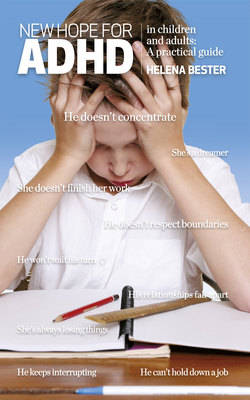Читать книгу New hope for ADHD in children and adults - Helena Bester - Страница 47
ОглавлениеPart 2: Conditions sometimes associated with ADHD
There is a growing tendency to diagnose so-called co-morbid or associated conditions in ADHD sufferers. Some of the most common include:
Oppositional defiant disorder (ODD)
According to Professor André Venter of the University of the Free State, ODD is one of the conditions most frequently associated with ADHD. About half of the children in the combined ADHD group suffer from ODD, while a quarter of those in the inattentive group can be diagnosed with ODD. This condition leads to behavioural problems that should not be treated with medication alone.
Children diagnosed with ODD manifest oppositional or defiant behaviour. They lose their temper, are argumentative and refuse to obey rules or respond to requests. These children usually blame others for their mistakes. (Even ADHD sufferers who do not display oppositional behaviour, have this tendency.) They are often vengeful and spiteful. These symptoms often manifest when the ADHD child experiences himself as a failure and carries a lot of frustration and anger.
Conduct disorder (CD)
Conduct disorder is a much more serious behavioural problem than ODD. A quarter of children, adolescents and adults with combined ADHD, show clear symptoms of CD.
Children diagnosed with CD do not show respect for the basic rights of others. They threaten or intimidate other children, often initiate fights and generally exhibit aggression and even cruelty towards people and/or animals. Children with CD often run away from home or stay out the whole night. Serious transgressions, such as damage to property and theft, are sometimes committed. A multidisciplinary team should be involved in the treatment of such a child.
CD is diagnosed in adult ADHD sufferers if the person does not meet the criteria for a diagnosis of antisocial behaviour disorder.
Disruptive mood dysregulation disorder (DMDD)
Disruptive mood dysregulation disorder, a new diagnosis in the DSM-5, may also be diagnosed in addition to ADHD. This disorder is not diagnosed for the first time before the age of six years or after the age of eighteen, and must have started before the age of ten years. Children suffering from DMDD have regular temper tantrums (an average of three or four a week). The rage is expressed either verbally or through aggressive behaviour. When aggression is not expressed verbally or in actions, the children generally appear to be irritable. The anger and irritation are obvious to teachers, parents and friends.
Gilles de la Tourette syndrome
With this syndrome, commonly known as Tourette’s syndrome, ADHD symptoms may manifest in combination with obsessive compulsive behaviour and nerve and/or muscular spasms. A diagnosis is made only when uncontrolled sounds, as well as muscle tics are present for longer than six months.
Previously it was believed that sufferers of Tourette’s syndrome could not use Ritalin. However, nowadays the medication is regularly prescribed for sufferers.
The effectiveness of neurotherapy as a treatment for Tourette’s syndrome looks promising. Neurotherapy is discussed in chapter 10.
Mood disorders
Depression and bipolar disorder sometimes occur in ADHD sufferers. Depression occurs in a minority of ADHD sufferers, but more often than in the general population.
Anxiety disorders
Anxiety disorders are also diagnosed fairly often in hyperactive-impulsive ADHD sufferers in particular. Among children, separation anxiety is reasonably common, while adults will exhibit symptoms of general anxiety. (Stimulant medication can exacerbate an anxiety disorder.)
Obsessive-compulsive behaviour disorder is another anxiety disorder sometimes associated with ADHD.
Intermittent explosive disorder (IED)
This disorder occurs in a minority of adult ADHD sufferers, but more often than in the general population.
The behaviour of those who suffer from IED is characterised by regular episodes of impulsive, aggressive and even violent acts or verbal outbursts that do not relate logically to the circumstances. Road rage, the abuse of loved ones and the destruction of property are not uncommon with this disorder.
Drug dependence
The occurrence of drug dependence is greater among those with ADHD than among the general population.
Autism-spectrum disorder
According to the guidelines specified in DSM-5, the diagnosis of ADHD can also be made in the presence of autism-spectrum disorder. In the previous DSM, one diagnosis preluded the other. Asperger’s syndrome as part of the autism-spectrum disorder is no longer specified in the DSM-5.
Autism sufferers have severe problems with social interaction and communication in particular. They display unusual and repetitive behaviour, and their interests are limited. Some sufferers have a serious language deficit, although not all do.
Learning problems
Delays in reading and spelling are common in children with ADHD. Problems in mathematical literacy may also occur. Because specific learning disorders commonly co-occur with ADHD, barriers to learning or learning problems are discussed in more detail in chapter 7.
In the next chapter we return to the less technical – and, from the parent’s and teacher’s perspective – the more rel-evant implications of an ADHD diagnosis. We discuss the emotional reality which, for various reasons, parents and teachers have to grapple with.
